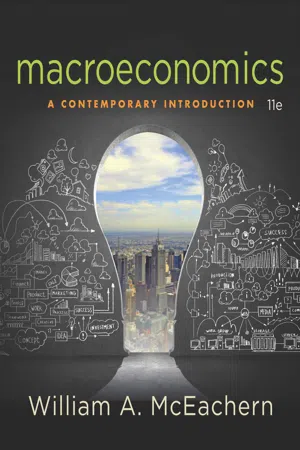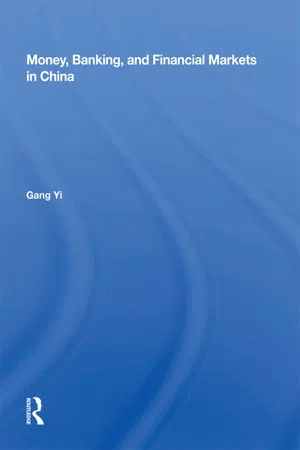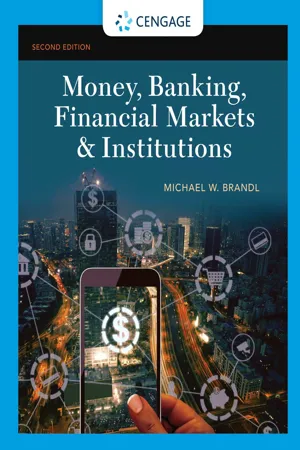Economics
Change in Money Supply
Change in money supply refers to the alteration in the total amount of money available in an economy. This can occur through various means, such as central bank policies, government interventions, or changes in banking practices. An increase in the money supply can lead to inflation, while a decrease can result in deflation, impacting the overall economic conditions.
Written by Perlego with AI-assistance
Related key terms
1 of 5
7 Key excerpts on "Change in Money Supply"
- eBook - PDF
Macroeconomics
A Contemporary Introduction
- William A. McEachern(Author)
- 2016(Publication Date)
- Cengage Learning EMEA(Publisher)
And a worldwide shortage of credit in 2007–2009 caused by mortgage defaults in the United States prompted the Fed to supply additional liquidity to the banking system to ensure the orderly functioning of financial markets. Central banks around the world have also begun coordinating their activities, par- ticularly during economic turmoil. For example, in October 2008, during the global financial crisis, six major central banks reduced interest rates in a joint effort to restore financial stability to world markets. Bernanke said he was in frequent contact with other central bankers, including Mario Draghi, head of the European Central Bank. (Incidentally, Draghi, like Bernanke, earned a Ph.D. in economics from MIT.) Although not the main focus of monetary policy, international considerations are of growing importance to the Fed, particularly because of recent fiscal instability in the eurozone. 15-5 Conclusion This chapter has described two ways of viewing the effects of money on the economy’s performance, but we should not overstate the differences. In the model that focuses on the short run, an increase in the money supply means that people are holding more money than they would like at the prevailing interest rate, so they exchange one form of wealth, money, for other financial assets, such as corporate or government bonds. This greater demand for other financial assets has no direct effect on aggregate demand, but it does reduce the interest rate, and thereby stimulates investment. The higher invest- ment increases aggregate demand. The effect of this increase in demand on real output and the price level depends on the shape of the short-run aggregate supply curve. In the model that focuses on the long run, changes in the money supply act more directly on the price level. If velocity is relatively stable or at least predictable, then a change in the money supply has a predictable effect on the price level in the long run. - eBook - PDF
Monetary Economics
Policy and its Theoretical Basis
- Keith Bain, Peter Howells(Authors)
- 2017(Publication Date)
- Red Globe Press(Publisher)
To test for this, we need a clear definition of money and the argument above suggests that this should be a narrow defini-tion. However, if the supply of money is endogenous, the demand for money loses much of its importance and our need for a precise definition of money is also much diminished. In fact, for much of its history, monetary economics has been dominated by the combined assumptions of an exogenous money supply and a stable demand for money. This was not because very many economists thought that it provided an accurate description of economies in practice. Rather it derived from the view that the economic system could best be analysed by assuming well-informed eco-nomic agents and markets that tend towards equilibrium. In such a world, cur-rent real income is always at its equilibrium level and this level is known. Savings decisions reflect the long-term choice between the present and future consump-tion (of goods and services), a real not a monetary decision. All savings are The meaning of money 14 Pause for thought 1.5 Can you explain why a stable demand for money implies a stable velocity of money? invested and the level of investment determines the rate of growth of capital stock, which in turn ensures the desired future level of output. The real rate of interest is determined by the actions of savers and investors. The plans of eco-nomic agents are always fulfilled. There is no uncertainty and no scope for pure-ly financial transactions. The monetary authorities determine the rate of growth of the money supply. Given the stable demand for money, the control of the money supply provides control over the rate of growth of aggregate demand and, with the rate of growth of output determined by real factors, the price level and the rate of inflation. In such a model, money is neutral. We can see this as anoth-er form of the notion that money acts as a veil over the real economy. - Gang Yi(Author)
- 2019(Publication Date)
- Routledge(Publisher)
Money (Ml}= (Currency in circulation+ Deposits of other domes-tic transactor + Demand deposit in the banking system + Demand deposit in rural credit co-ops). 2. Quasi-money is defined as the sum of time deposit of institutions plus the total urban and rural households' saving. 3. M2 is defined as money plus quasi-money. 4. Reserve money = currency in circulation + Banks' reserve + De-posits of other domestic transactor. SOURCE: International Financial Statistics Yearbook, 1993, Interna-tional Monetary Fund (IMF), Washington, D.C. 5 The Money Supply Process There a.re many articles in the recent literature that discuss different aspects of the financial sector in China. For example, Feltenstein and Farha-dian ( 1987) construct a model of inflation by using a general equilibrium (or disequilibrium) framework. Chow (1987) estimates the demand for money in China. Perkins (1988) discusses the relationship between price reform and inflation. Feltenstein and Ha (1989) estimate the repressed inflation and liquidity overhang. Yi (1991b) discusses the monetization process. The task of this chapter is to investigate the money supply process. During economic reform, the banking system in China has changed from an all-inclusive mono-banking system to a more or less market-oriented central bank system. The money supply mechanism in this semi-reformed environment is unique in the sense that it has attributes of both a centrally planned economy and a market economy. Study of the money supply mech-anism is the primary focus of this chapter, which is organized as follows. Section 5.1 defines the monetary base and examines its components. Sec-tion 5.2 discusses the factors that influence the monetary base. The next section analyzes the multiplier effect of the money creation process. The fourth section addresses the factors that influence the multiplier and its predictability. The final section summarizes the relationship between the money supply and the monetary base, the multiplier.- eBook - PDF
India's Economic Prospects - A Macroeconomic And Econometric Analysis
A Macroeconomic and Econometric Analysis
- Thampy Mammen(Author)
- 1999(Publication Date)
- World Scientific(Publisher)
Chick (1983) points out that there is a revolving fund consisting of consumption and investment spending, and profit and wage income which remain within the banking system as its liability that could finance the existing level of spend-ing. Any higher level of spending in investment or any other spending will necessitate a larger revolving fund that would be met by the banks. (The reason there is a revolving fund is that the short term finance provided by the bank to the producer while goods are being produced will be spent on resources such as labor and returned to the banking system as deposits, with the exception of some leakage into cash or other types of financial as-sets (Wray 1990). Since bank money is created in the process of production or speculation, money supply is the result, rather than the cause, of aggre-gate demand (Roger 1989, p. 175). The reason for the stable relationship between income (Y) and money (M), argues Kaldor, is that the causation runs from Y to M and not from M to Y. New money comes into existence in consequence of, or as an aspect of, the extension of bank credit. (Kaldor 1982, p. 22). Expenditures are financed by credit, which raises the level of the money supply. So money supply is demand-determined. But demand may vary with income, and the Central Bank can effectively influence the level of credit through changes in the bank rate. That, however, does not alter the fact that demand determines the money supply (ibid., p. 24). Supply and Demand for Money 157 The central bank cannot control the monetary base except through changing the bank rate at which it creates bank reserves through lend-ing or discounting. But it cannot refuse to lend to the banks without endangering the solvency of the banking system; they must maintain their function as a lender of the last resort, (ibid., p. 25). Moore makes the same argument: The banks first meet the demand for loans and then meet the legal reserve requirement. - Michael Brandl(Author)
- 2020(Publication Date)
- Cengage Learning EMEA(Publisher)
If the money supply does not increase fast enough, there may not be enough money for transactions to take place. Thus, because few transactions take place, output decreases and the economy contracts. These con-tractions in the economy can lead to an economic recession or, as Milton Friedman pointed out, even economic depressions. Thus, we care about the growth rate of the economy’s money supply because “too much” money can lead to inflation, whereas “not enough” money can lead to economic recessions and depressions. This should convince you that the growth rate of the money supply is what matters the most. But this also raises the question, What functions as money? Next we look at the issue of the different types of money used today and how the money supply is actually measured. 2-2b Money through Time Financial historians tell us that through time a wide variety of assets have functioned as money. Centuries ago, commodities—things such as fur pelts, wheat, or gold—were used as money. Commodity money is an asset that is used as money but also has another, or different, use. For any asset to function as money, it must meet certain criteria. These criteria include the following: • It must be easily standardized so that the prices of two units can be easily compared. That is, the good that is functioning as money has to be homogenous or the same. For example, if gold is to be used, a purity standard must be agreed to, such as 99% pure gold per ounce. If a bushel of wheat is to be used as a money, the weight, quality, color, and so on of the wheat that makes up that bushel need to be agreed to. • It must be easily divisible . Not all goods are going to have their value stated in nice round amounts; sometimes you have to “make change.” Copyright 2021 Cengage Learning. All Rights Reserved. May not be copied, scanned, or duplicated, in whole or in part. Due to electronic rights, some third party content may be suppressed from the eBook and/or eChapter(s).- Michael Brandl(Author)
- 2016(Publication Date)
- Cengage Learning EMEA(Publisher)
Due to electronic rights, some third party content may be suppressed from the eBook and/or eChapter(s). Editorial review has deemed that any suppressed content does not materially affect the overall learning experience. Cengage Learning reserves the right to remove additional content at any time if subsequent rights restrictions require it. 10 CHAPTER 2 Sample Design About Money Amount of Money and Money Through Time Hopefully you are convinced that a modern economic system needs money to allocate resources in a reasonably efficient way, and for an asset to function as money it must be a medium of exchange, be a unit of account, and have a store of value. Next we want to consider why the amount or growth of the money supply matters. Then we will examine how different assets have served as money over time. 2-2a The Amount of Money Matters While the content presented in the previous section makes a compelling argument for why money is important, most modern economists, and professionals working in financial markets, worry more about the quantity of money as opposed to what actually functions as money. To understand why the quantity of money is such an important concept, let’s think more about the growth rate of the money supply. In 1811 David Ricardo published a widely read book called The High Cost of Bullion in which he argued that inflation occurs when the money supply grows too quickly. In the 1960s Milton Friedman offered a corollary to this, arguing that the Great Depression of the 1930s came about because the money supply contracted in the early days of the Depression. These two ideas can be summarized as follows: If the money supply increases too quickly, you have too much money chasing too few goods. On the other hand, if the money supply does not grow fast enough, there will not be enough money for transactions to take place and the economy will slide into a reces-sion or a depression. To see why this is the case, imagine a classroom with 45 students.- eBook - PDF
Economics
Theory and Practice
- Patrick J. Welch, Gerry F. Welch(Authors)
- 2016(Publication Date)
- Wiley(Publisher)
By the end of this chapter, you will have a good understanding of an area of the macroeconomy that seems mysterious to many Money Creation, Monetary Theory, and Monetary Policy CHAPTER 8 204 Chapter 8 Money Creation, Monetary Theory, and Monetary Policy people but is critical to economic stabilization and growth. And, just a hint: some of the material in the first few pages of this chapter is less than exciting. But by working through these pages carefully and thoughtfully, the rest of the chapter and an area of the economy that plays a critical role in your life will be easy to understand. THE MONEY SUPPLY AND THE LEVEL OF ECONOMIC ACTIVITY Let’s begin by summarizing some of the key lessons learned in Chapter 5. ♦ Total, or aggregate, spending drives the economy’s levels of production, employment, and income and sometimes overall prices. ♦ Total spending is found by adding together the spending of all four major macroeconomic sectors: household, business, government, and foreign. ♦ Increases in total spending lead to increases in production, employment, and income unless the economy is at full employment. ♦ At (or near) full employment, increases in spending lead to overall price increases, or demand‐pull inflation. ♦ Decreases in total spending result in a decline in production, employment, and income and may dampen inflation. Household and business spending is related to the amount of money in the econ- omy: An increase in the money supply increases spending, and a decrease in the money supply decreases spending. We learned in Chapter 7 that money is created when finan- cial depository institutions, such as commercial banks, make loans. Because house- holds typically borrow to finance the purchase of homes, automobiles, appliances, and other consumer products and businesses typically borrow to invest in buildings, machinery, equipment, and such, increased loan making results in increased spending.
Index pages curate the most relevant extracts from our library of academic textbooks. They’ve been created using an in-house natural language model (NLM), each adding context and meaning to key research topics.






